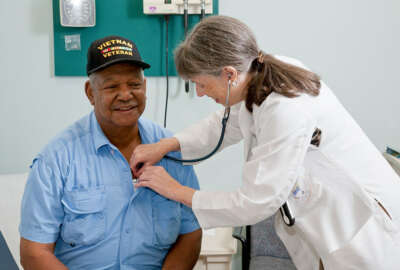
How VA drastically expanded telehealth during the pandemic
The Department of Veterans Affairs expanded telehealth appointments by 1000% during the coronavirus pandemic. Both VA and Congress seem to agree: telehealth is here...
As the Department of Veterans Affairs canceled and postponed in-person medical appointments, the agency moved mountains to quickly expand its telehealth capacity during the coronavirus pandemic.
The numbers tell most of the story.
VA conducted about 2,500 telehealth video sessions daily at the beginning of March. Today, VA is conducting nearly 25,000 sessions — a 1000% increase.
The department also boosted bandwidth for concurrent video sessions up by factor of five during the pandemic.
The department delivered more than 2 million episodes of telehealth care in fiscal 2019. This year to date, VA has delivered more than 9 million telehealth episodes to date, including 1.1 million virtual mental health appointments.
“What we needed was for our workforce to lean in, and they did,” Jennifer MacDonald, chief consultant to the deputy undersecretary for health at the Veterans Health Administration, told House members Tuesday. “We needed the capacity of our technology to be expanded, and IT came through for us in close partnership with us. We needed the processes of the organization to evolve rapidly to support this.”
Telehealth successes during the pandemic were due, in part, because nearly two-thirds of primary care and mental health providers had already used VA Video Connect, the department’s main virtual conferencing platform.
Congress was largely impressed.
“Although the telehealth help desk was initially unprepared and swamped by the volume of calls, speed to answer is now about two seconds,” Jim Banks (R-Ind.), ranking member of the House Veterans Affairs Subcommittee on Technology Modernization, said. “About 95% of calls are successfully completed. Whereas other health care systems simply canceled appointments or postponed them indefinitely, VA was able to convert hundreds of thousands of those consults into telehealth sessions.”
The success, of course, came at a cost. VA’s Office of Information and Technology received nearly $2 billion in supplemental funding through the Coronavirus Aid, Relief and Economic Security Act, which covered video conferencing enhancements and other infrastructure improvements.
The department is also pursuing 200,000 laptops for its workforce, including telehealth users and teleworking employees.
“We also have invested heavily in bandwidth modernization and in key critical care areas,” Jack Galvin, VA’s acting deputy assistant secretary for IT development security operations, said. “We are poised to scale a sustainable expansion of telehealth, as well as other areas, including the vast increase in telework. We experienced about an 80,000-person uptick in the amount of people who work in a telework environment.”
The Veterans Health Administration also received an additional $17.2 billion for medical support. The department so far has spent $38.9 million on telehealth initiatives and equipment, including 20,000 4G connected iPads for veterans who lack the technology or wireless Internet needed to connect with their providers.
VHA has also purchased another 8,000 iPads for its providers, as well as 24,000 webcams, 22,000 headsets and 10,000 speakers to support to telehealth appointments.
“We worked week over week with IT to make sure that we could stay ahead of that demand,” Kevin Galpin, executive director of telehealth services at the Veterans Health Administration, said. “We definitely ran into capacity strain on the system at times, we saw that. Fortunately with all the great work that was done we are now on the other side of that, and we’re excited to be there and able to expand even more.”
VHA and the department’s IT teams are also planning a further expansion of the telehealth help desk.
“We had so many calls coming in, because so many people were docking the technology that we had really almost quadruple the size of our help desk, somewhere between triple and quadruple, to make sure we could handle the load,” Galpin said.
Both VA and Congress seem to agree: telehealth is here to stay. But determining the appropriate mix of VA telehealth and in-person care for the future is the next challenge.
In the short-term, VA will rely on telehealth to some extent as its medical facilities slowly begin to offer more in-person medical services.
The pandemic forced the department to cancel some 5.7 million appointments with VA providers in between Feb. 1 and April 7. Telehealth replaced some of those appointments, but as many as 2.3 million may need to be rescheduled, Richard Stone, VHA’s executive in charge, told Congress earlier this month.
In the long term, VA said it will “sustain and grow” its telehealth capabilities. It doesn’t yet have a concrete target for how many telehealth users can and should regularly use VA platforms.
“I don’t think we know that yet,” Gaplin said. “What we want to do is get to the point where this is just part of the integrated solution for care, so that a veteran and a provider can sit at every visit and say, ‘How do we want to deliver the next step of care? Is it by phone? Is it in person? Is it by video?’ All those options are equivalent. They’re all equally simple. They’re all accessible. At that point once we achieve that, we’ll start knowing what is the preference of the veteran. What is the clinical capability of the provider who can deliver that service? I don’t think we have that data or that ability to predict.”
And though VA is distributing iPads and other tools to veterans who lack the technology they need to connect virtually with their providers, some veterans service organizations said the initiative missed their constituents.
“We cannot assume that scaling up equals access,” Rep. Susie Lee (D-Nev.), the subcommittee’s chairman, said. “Access to care remains an issue for many veterans, whether it is because of geography, lack of resources or infrastructure or because of systematic disadvantages.”
Copyright © 2025 Federal News Network. All rights reserved. This website is not intended for users located within the European Economic Area.
Nicole Ogrysko is a reporter for Federal News Network focusing on the federal workforce and federal pay and benefits.
Follow @nogryskoWFED
Related Stories





